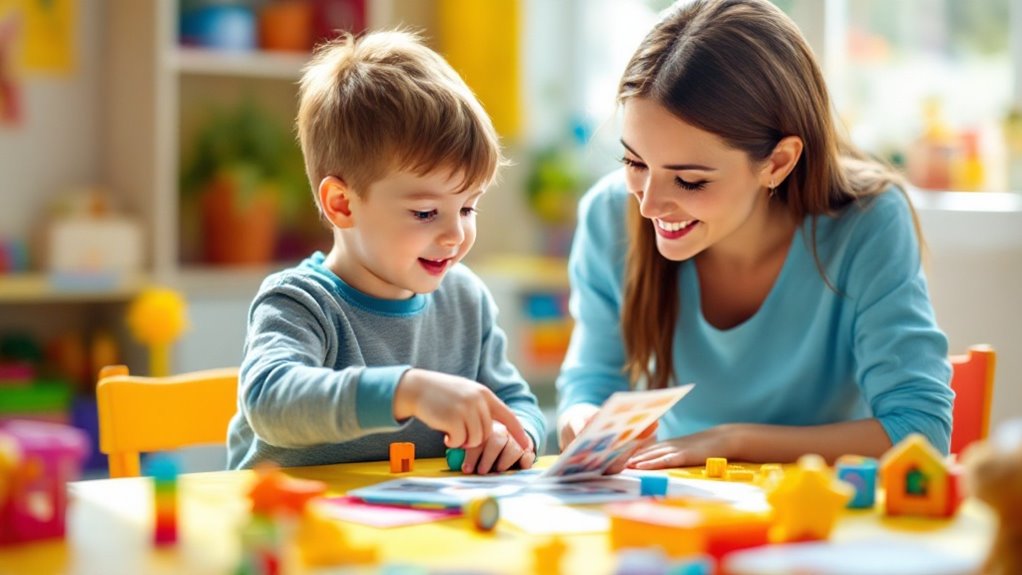A typical ABA therapy session is all about creating a comfortable environment for your child to learn and grow. It starts with a warm greeting, making sure everyone feels at ease. The therapist will review goals tailored just for your child, followed by structured activities that mix fun and learning. You might see things like games to boost social skills or tasks using visual aids. Throughout, your therapist provides immediate feedback and celebrates those small wins with your child. Each session is a step forward, and you’ll discover even more about what to expect and how to support your child.
Key Takeaways
- Sessions begin with a warm greeting, setting a positive tone for the child’s engagement and comfort.
- Goals are reviewed to maintain clarity and focus, ensuring alignment with the child’s needs.
- Structured activities are introduced, combining direct teaching and play-based learning to enhance vital skills.
- Therapists monitor responses and adjust activities in real-time to optimize engagement and support learning.
- Sessions conclude with a debrief, discussing successes and areas for improvement to foster growth.
Overview of ABA Therapy
C:\Users\Brandon\Downloads\zimmwriter_v10.773\zimmwriter\output\What_Does_a_Typical_ABA_Therapy_Session_Look_LikeTargets_Families_Curious_About_the_Structure_and_A_0001.jpg
ABA therapy, or Applied Behavior Analysis, is a structured approach designed to improve specific behaviors and skills through observation and reinforcement. You might be wondering how this all works and what it means for you and your loved ones. Fundamentally, ABA focuses on understanding why behaviors occur and how to encourage positive changes in a supportive environment.
In each session, a trained therapist will assess your child’s unique needs and tailor strategies that resonate with them. You’ll likely see a mix of activities, from direct teaching to play-based learning, all aimed at fostering vital skills. This isn’t a one-size-fits-all method; it’s about building on your child’s strengths and addressing areas that may need extra attention.
As a parent or caregiver, you play an integral role in this process. Your involvement helps create a sense of belonging and understanding, which is essential for effective learning.
Setting Goals and Objectives
As you engage in ABA therapy, setting clear goals and objectives becomes a fundamental part of the process. This isn’t just about ticking boxes; it’s about creating a roadmap tailored to your child’s unique needs. Together with your therapist, you’ll identify specific skills your child can work on, whether it’s improving communication, social interactions, or daily living skills.
It’s vital to guarantee these goals are realistic and achievable. You’ll want to break them down into smaller, manageable steps. This way, your child can experience success along the way, boosting their confidence and motivation.
Remember, it’s not just about reaching the end goal but also celebrating those small victories that matter so much.
As you collaborate with your therapist, don’t hesitate to voice your insights and concerns. Your perspective is invaluable. By setting these goals together, you’re fostering a sense of partnership that’s essential in this journey.
The more involved you are, the more your child will benefit. Ultimately, the aim is to empower your child, helping them grow and thrive in a supportive environment where they truly belong.
Structure of a Session

Every ABA therapy session is like a carefully crafted blueprint, designed to maximize your child’s learning and engagement. You’ll often find that a session begins with a warm greeting, setting a positive tone. This initial connection helps your child feel comfortable and ready to participate.
Next, the therapist typically reviews the goals and objectives you’ve established together. This step guarantees that everyone is on the same page and provides a clear focus for the session.
After that, the therapist introduces structured activities tailored to your child’s unique needs. These activities create an environment where learning feels natural and fun.
As the session progresses, the therapist monitors your child’s responses and adjusts activities as needed. This flexibility is key; it allows the therapist to respond to your child’s mood and engagement level.
Finally, the session wraps up with a debrief. You’ll hear about what went well and any areas for improvement, fostering a sense of collaboration. By understanding this structure, you can feel more connected to your child’s journey, knowing that every session is designed to support their growth and development.
Typical Activities and Techniques
In a typical ABA therapy session, you’ll encounter a variety of engaging activities and techniques designed to support your child’s learning. These sessions often begin with warm-up activities that help your child feel comfortable and ready to participate.
You might see fun games that promote social skills, communication, and turn-taking, which are essential for building connections with others. As the session progresses, your child may participate in structured tasks that target specific goals.
These could involve using visual aids or interactive materials that make learning enjoyable and relatable. Techniques like prompting and reinforcement are commonly used to guide your child’s behavior, ensuring they understand what’s expected of them.
You’ll also notice plenty of positive reinforcement. Celebrating small successes, whether it’s verbal praise or a tangible reward, helps motivate your child and encourages them to keep trying.
Throughout the session, therapists adapt activities based on your child’s needs and responses, ensuring that the experience feels personalized and supportive. Ultimately, the goal is to create a nurturing environment where your child can thrive, learn, and grow, fostering a sense of belonging and achievement within them.
Role of the Therapist
After engaging in various activities and techniques, you’ll find that the therapist plays a pivotal role in guiding your child’s learning journey. They’re not just instructors; they’re compassionate mentors who understand your child’s unique needs.
With their expertise in Applied Behavior Analysis, they tailor strategies that resonate with your child’s learning style, fostering a sense of belonging and connection.
As the session unfolds, the therapist creates a supportive environment where your child feels safe to explore and learn. They actively observe, providing immediate feedback to reinforce positive behaviors and gently redirecting when necessary. This real-time guidance helps your child build confidence, encouraging them to take risks and embrace challenges.
Moreover, the therapist communicates with you, sharing insights about your child’s progress and celebrating small victories together. This collaborative approach fosters trust, making you feel like a valued partner in the process.
You’ll appreciate how the therapist listens to your concerns, ensuring that your family’s goals are integrated into the therapy.
Ultimately, the therapist’s role is to empower your child, equipping them with essential skills while creating a nurturing space where they can thrive. You’re not alone in this journey; your therapist is there every step of the way.
Measuring Progress and Success
Tracking your child’s progress in ABA therapy can feel like a journey of discovery. Each session unfolds new insights about your child’s strengths and areas for growth. You might notice small victories—a new word spoken, improved eye contact, or a greater willingness to engage in play. These moments are milestones, and they deserve celebration.
Your therapist will use data collection methods, like direct observation and skill assessments, to measure progress. You’ll see charts and graphs that translate your child’s achievements into tangible results. It’s important to remember that progress isn’t always linear; some days may feel slower than others. This is completely normal!
Regular communication with your therapist will help you understand the data and what it means for your child’s development. They can guide you in setting realistic goals and adapting strategies to fit your child’s evolving needs.
You’re not alone in this journey. Sharing experiences with other families can provide comfort and build a sense of community. Together, you can celebrate the progress, no matter how small, and foster an environment of growth and belonging for your child.
Frequently Asked Questions
How Long Does Each ABA Therapy Session Typically Last?
ABA therapy sessions usually last around 30 to 60 minutes. You’ll find this time allows for focused engagement, helping your child develop skills while building trust and connection with their therapist. It’s all about progress!
What Age Groups Can Benefit From ABA Therapy?
ABA therapy can benefit individuals of all ages, from toddlers to adults. You’ll find tailored approaches that meet each person’s unique needs, helping them develop essential skills for communication, social interaction, and daily living.
How Many Sessions per Week Are Recommended?
For ideal progress, most experts recommend 2 to 5 sessions per week. You’ll find that consistency helps your child build skills and confidence, creating a supportive environment for growth and connection within your family.
Can Parents Participate in the Therapy Sessions?
Absolutely, you can participate in the therapy sessions! Your involvement helps reinforce skills at home, fostering a supportive environment. Together, you’ll learn strategies that benefit your child and strengthen your bond. You’re an essential part of this journey!
What Qualifications Should a Therapist Have for ABA Therapy?
When choosing an ABA therapist, look for qualifications like a master’s degree in psychology or behavior analysis, certification from the Behavior Analyst Certification Board, and experience working with children. It’s essential for effective support and progress.
Conclusion
In conclusion, an ABA therapy session is all about creating a supportive and engaging environment for your child. By focusing on structured goals and fun activities, therapists help kids learn essential skills while making progress. Remember, it’s a partnership between you, your child, and the therapist. Stay involved, ask questions, and celebrate those little victories along the way. Together, you’re building a brighter future, one session at a time!




0 Comments